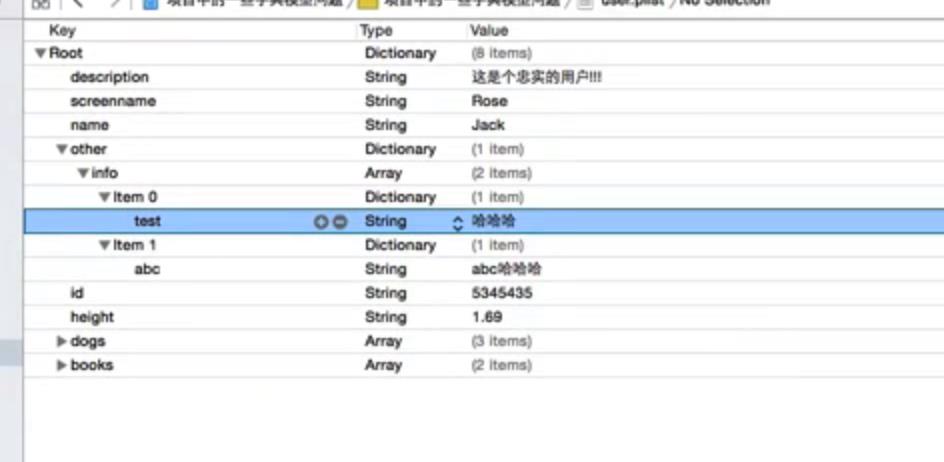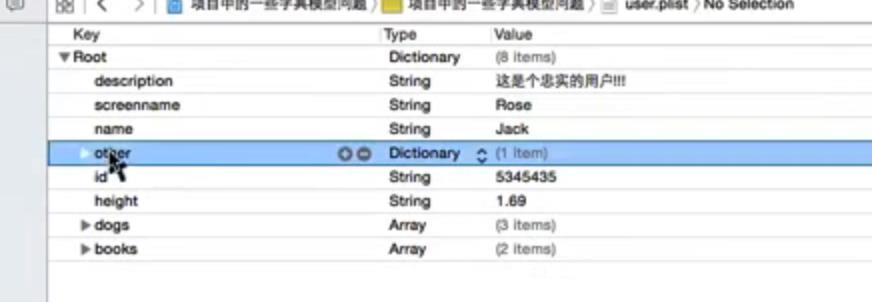ios开发网络学习二:URL转码以及字典转模型框架MJExtension的使用
Posted Hello_IOS
tags:
篇首语:本文由小常识网(cha138.com)小编为大家整理,主要介绍了ios开发网络学习二:URL转码以及字典转模型框架MJExtension的使用相关的知识,希望对你有一定的参考价值。
一:url转码,当url中涉及到中文的时候,要考虑转码,用UTF8对中文的url进行转码
#import "ViewController.h" @interface ViewController () @end @implementation ViewController #pragma mark ---------------------- #pragma mark Events -(void)touchesBegan:(NSSet<UITouch *> *)touches withEvent:(UIEvent *)event { [self post]; } #pragma mark ---------------------- #pragma mark Methods -(void)get { NSString *urlStr = @"http://120.25.226.186:32812/login2?username=小码哥&pwd=520it&type=JSON"; NSLog(@"转码前: %@",urlStr); //中文转码处理 urlStr = [urlStr stringByAddingPercentEscapesUsingEncoding:NSUTF8StringEncoding]; NSLog(@"转码后: %@",urlStr); //1.url NSURL *url = [NSURL URLWithString:urlStr]; //http://120.25.226.186:32812/login2?username=%E5%B0%8F%E7%A0%81%E5%93%A5&pwd=520it&type=JSON NSLog(@"url------%@",url); //2.urlrequest NSURLRequest *request = [NSURLRequest requestWithURL:url]; //3.connect [NSURLConnection sendAsynchronousRequest:request queue:[NSOperationQueue mainQueue] completionHandler:^(NSURLResponse * _Nullable response, NSData * _Nullable data, NSError * _Nullable connectionError) { //容错处理 if (connectionError) { NSLog(@"%@",connectionError); return ; } //4.解析 NSLog(@"%@",[[NSString alloc]initWithData:data encoding:NSUTF8StringEncoding]); }]; } -(void)post { //观察URL中是否有中文,如果有中文则需要转码 NSString *urlStr = @"http://120.25.226.186:32812/login2"; //username=小码哥&pwd=520it&type=JSON //1.url NSURL *url = [NSURL URLWithString:urlStr]; //2.urlrequest NSMutableURLRequest *request = [NSMutableURLRequest requestWithURL:url]; //2.1 post request.HTTPMethod = @"POST"; //2.2 body request.HTTPBody = [@"username=小码哥&pwd=520it&type=JSON" dataUsingEncoding:NSUTF8StringEncoding]; //3.connect [NSURLConnection sendAsynchronousRequest:request queue:[NSOperationQueue mainQueue] completionHandler:^(NSURLResponse * _Nullable response, NSData * _Nullable data, NSError * _Nullable connectionError) { //容错处理 if (connectionError) { NSLog(@"%@",connectionError); return ; } //4.解析 NSLog(@"%@",[[NSString alloc]initWithData:data encoding:NSUTF8StringEncoding]); }]; } @end
二:MJExtension的使用
1:字典转模型框架
1)相关框架
a.Mantle 需要继承自MTModel
b.JSONModel 需要继承自JSONModel
c.MJExtension 不需要继承,无代码侵入性
(2)自己设计和选择框架时需要注意的问题
a.侵入性
b.易用性,是否容易上手
c.扩展性,很容易给这个框架增加新的功能
(3):MJExtension的使用
1:字典转模型:
1://file:是读取本地的数据本地的资源包存在NSBundle中,url是获取网络端的数据
NSDictionary *dict = [NSDictionary dictionaryWithContentsOfFile:[[NSBundle mainBundle] pathForResource:@"person" ofType:@"plist"]];
XMGPerson *person = [XMGPerson mj_objectWithKeyValues:dict];
2:当网络数据既有字典又有数组字典的时候:需要在模型中重写:
+ (NSDictionary *)mj_objectClassInArray方法。以下两种方试都可以
+ (NSDictionary *)mj_objectClassInArray
{
// key : 属性名
// value : 类名
return @{
@"dogs" : @"XMGDog",
@"books" : @"XMGBook"
};
// return @{
// @"dogs" : [XMGDog class],
// @"books" : [XMGBook class]
// };
}
3:当需要改变网络返回数据的key值时:如遇到系统关键字id或是description时,需要在模型中重写
+ (NSDictionary *)mj_replacedKeyFromPropertyName
+ (NSDictionary *)mj_replacedKeyFromPropertyName
{
// 属性名-字典key-映射
// key : 属性名
// value : 字典中的key
return @{
@"desc" : @"description",
@"ID" : @"id",
@"name" : @[@"name", @"screenname"],//表示属性name既可以对应name也可以对应screenname,优先查看name的值若是name的值没有,则查看screenname的值
@"info" : @[@"other.info[1].abc",//此种情况的数据情况如图:点语法是为字典的key赋值,[]表示数组中的第几个对象,.abc表示这个对象下的test
@"other.info[0].test",
@"name"]
};
}

注意:如果服务器返回的数据最外层是字典,字典中又有字典A,字典A中又有其他字典,数据结构如图:

解决办法:1:可以用字典转模型,将other字典再构造一个模型 ,字典转模型 2:还可以在数据model中重写+ (NSDictionary *)mj_replacedKeyFromPropertyName方法,
+ (NSDictionary *)mj_replacedKeyFromPropertyName
{
// 属性名-字典key-映射
// key : 属性名
// value : 字典中的key
return @{
@"desc" : @"description",
@"ID" : @"id",
@"name" : @[@"name", @"screenname"],//表示属性name既可以对应name也可以对应screenname,优先查看name的值若是name的值没有,则查看screenname的值
@"info" : @"other.info"
};
}
4:MJExtension在项目中的应用:一般为了减少 MJExtension对项目的侵入性,基本做法都是新建配置类继承NSObject,在配置类中实现+(void)load方法,在此方法中对模型中的字段进行配置
#import "XMGExtensionConfig.h" #import "XMGUser.h" #import "XMGBook.h" #import "XMGDog.h" #import <MJExtension.h> #import "XMGOther.h" #import "XMGPerson.h" @implementation XMGExtensionConfig + (void)load { #pragma mark - XMGUser [XMGUser mj_setupReplacedKeyFromPropertyName:^NSDictionary *{ return @{ @"desc" : @"description", // @"ID" : @"id", @"name" : @[@"name", @"screenname"], @"info" : @[@"other.info[1].abc", @"other.info[0].test", @"name"] }; }]; [XMGUser mj_setupObjectClassInArray:^NSDictionary *{ return @{ @"dogs" : @"XMGDog", @"books" : @"XMGBook" }; }]; #pragma mark - XMGPerson [XMGPerson mj_setupReplacedKeyFromPropertyName121:^NSString *(NSString *propertyName) { // if ([propertyName isEqualToString:@"ID"]) return @"id"; return [propertyName mj_underlineFromCamel]; }]; #pragma mark - XMGBook // [XMGBook mj_setupReplacedKeyFromPropertyName:^NSDictionary *{ // return @{@"ID" : @"id"}; // }]; #pragma mark - XMGDog // [XMGDog mj_setupReplacedKeyFromPropertyName:^NSDictionary *{ // return @{@"ID" : @"id"}; // }]; [NSObject mj_setupReplacedKeyFromPropertyName:^NSDictionary *{ return @{@"ID" : @"id"}; }]; } @end
注意:1:在配置类中进行数据模型的配置,需要实现+(void)load方法,在此方法内进行配置,不需要导入头文件,因为+(void)load是在类加载进内存就会被调用,而且只会被调用一次,+(void)initialize 是累呗使用的时候调用,也是被调用一次 2:若是向一些参数模型,或是数据模型等含有重复的字段值,1:则可以抽重复的字段值抽成父类,让子类去继承,此时父类也可以提供初始化方法给子类继承,在父类初始化方法中父类可以为一些固定的属性赋值 2:用父类去进行初始化,也就是如上面代码所示,都含有ID的配置,则可以用父类NSObject去配置,因为任何类都是继承自NSObject,则此时子类就相当于配置了ID,它的原理就是oc的对象机制,先优先从子类中寻找,子类要是有此属性,就不再去父类寻找,子类若是没有此属性,则其会去父类中查找。
以上是关于ios开发网络学习二:URL转码以及字典转模型框架MJExtension的使用的主要内容,如果未能解决你的问题,请参考以下文章
ios开发runtime学习五:KVC以及KVO,利用runtime实现字典转模型